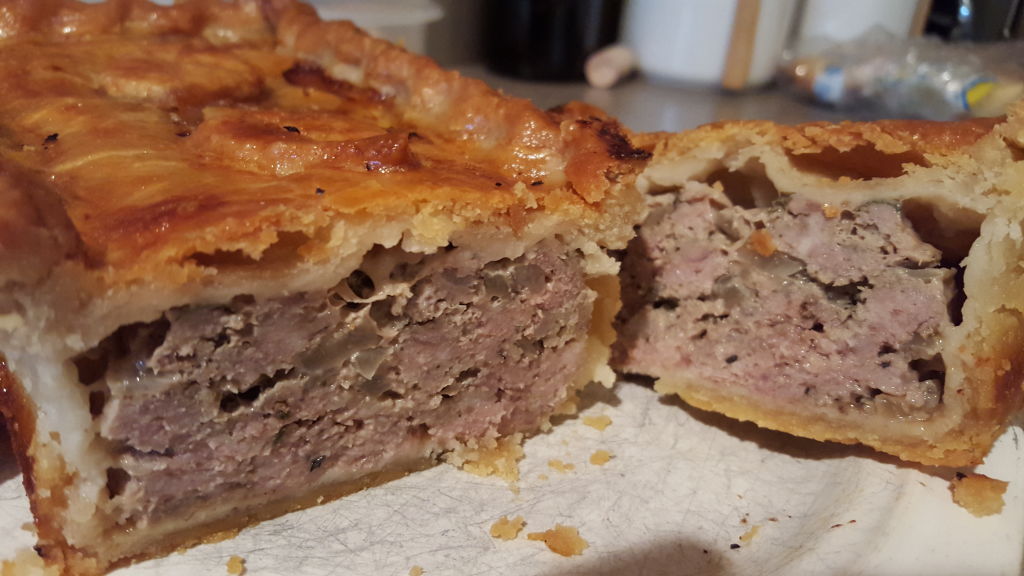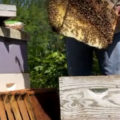While going through the freezer the other night making space for hunting season, I collected a number of pig trotters that were begging to have something done with them. I decided on pork pie. The trotters would be cleaned and boiled to make an aspic for the jelly. I depended on a mash of recipes and processes from the Internet as well as some charcuterie books. The components of a pork pie consist of the outer pastry shell, the meat filling, and the aspic, or jelly that is poured in before chilling the pie.

Here’s what I ended up with.
For the jelly, I rendered my pig trotters to make the aspic the day before since it alone takes about 3 hours to cook.
- 1 lb. of pig trotters. I had 4, and used them all
- 4 large chopped carrots
- 1 large chopped onion
- 1 chopped stick of celery
- 4-5 bay leaves
- 1 tbsp. of chopped parsley
- 1 tbsp. of thyme
- ½ tbsp. of peppercorns
I also had some dehydrated seasoned tomatoes that I added in. It’s OK to improvise. I cleaned and scraped off any hair or debris from the trotters. I also blanched them and drained the water before using. Add the trotters and all the ingredients above to a clean pot and fill with water until everything is just covered. Bring it to a boil and then reduce to a simmer for three hours. You can skim any scum as needed. Once done, strain and put back on the stove to simmer until the liquid is reduced by 30-40%. When this is chilled, it will turn to a jelly that can be cut with a knife, but not too rubbery. I chilled this until the next day, and reheated before using.

For the filling, I used just over a pound of 50/50 lean/fat pork that I had, but you can use shoulder, or other cuts you that you like.
- 1.3 lb pork and fat
- 1 chopped onion
- 1 tsp. sage
- 1 tsp. thyme
- 1/2 tsp. allspice
- I also added 2 cloves crushed garlic
- Salt and pepper to taste
Mix all the ingredients with the pork and fat, and add to your pan that is lined with the pastry shell. You do not need to pack the filling tight as you will want the space for the jelly to run down through later. Once the filling is added, roll out your lid, place it on top, and flute around the edges. I also added some leaves (since it’s fall, and I was inspired). Poke a hole about the size of your pinky in the top middle… or make two on each side. This hole will be used to pour the aspic in later after it’s cooled.
I had some filling left over, and so I made up another batch of pastry and lined muffin tins to make smaller personal pies.

The hot water pastry, simple, neat and quick since I had lard already rendered and ready. Really, you can use whatever pastry recipe you like, but I used,
- 4 oz. water
- 4 oz. lard
- 10 oz. flour
- ½ tsp. salt
- 1 egg beaten for the egg wash.
Boil the water and lard until the lard is melted. Add the salt and flour and mix until it forms into dough. The lard keeps the pan lubricated and you should be able to tip the dough out and knead it by hand before rolling it out. As the dough cools, it begins to harden. I found that I needed it to cool more so that it didn’t tear when I lifted it up to line the pan. Flour your surface, knead it and roll it out to about 1/8″ thick, and line a 3×6″ pan. Make sure you keep enough to make a lid for the pie.
Bake at 400°F for 30 minutes, then reduce the heat to 375°F and bake for another hour. You can remove it from the tin once it’s manageable, but this time, I let it stay in the pan.
Boil up the jelly and allow to cool a little. Using a funnel, pour the jelly into the pie through the hole(s) you made. Keep adding more jelly and allow it to settle before adding more. When the pie cools again, the jelly will set. Pork pie is traditionally eaten cold, but if you want to warm it a little, go for it. Just don’t warm so much that your jelly re-liquefies or you’ll be robbed of the savory flavor that is… pork pie.






















Leave a Reply